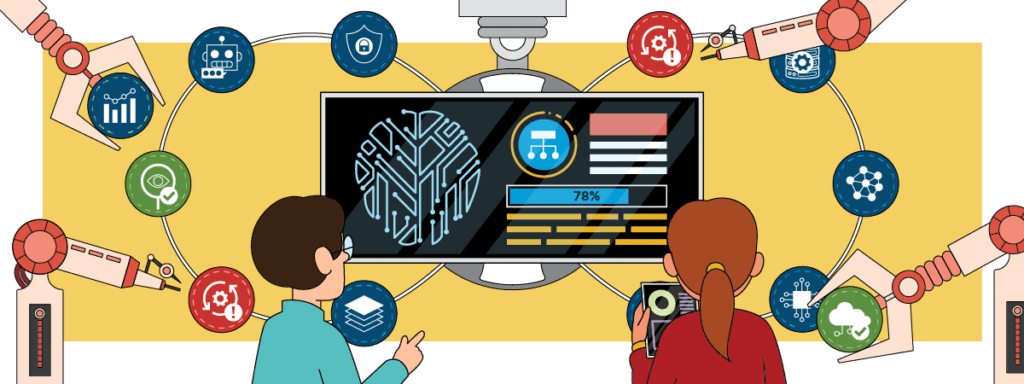
Take a moment and think back to a time when someone taught you something completely new. Perhaps it was when you learned to ride a bike. In the same way, teaching a machine is not too different from someone teaching you that new skill. It’s about breaking down complex tasks into understandable and manageable bits, then guiding the learner—whether it’s a child or a machine—through repetition and correction until they ‘get it.’
We live in a rapidly evolving world where artificial intelligence is becoming integral to our businesses, economies, and even our daily routines. But behind every sophisticated machine, there’s a journey of learning, trial, error, and adaptation.
Machine Teaching vs. Machine Learning
Machine teaching is like a first step before diving into machine learning. Think of it like teaching a friend how to do something before they try it independently. In machine teaching, people show computers how to do tasks. This helps us get ready for machine learning, where computers learn more on their own by practicing with data. So, by starting with machine teaching, we’re preparing to understand the bigger world of machine learning.
Distinctions in autonomy and human involvement
In machine teaching, the dynamics are like that of a mentor and mentee. The mentor (human) plays a pivotal role in guiding the learning process. In machine teaching, humans, acting as mentors, provide detailed guidance, curate experiences, and give feedback. The machine, akin to a mentee, absorbs these inputs and acts upon them. Here, the machine, as the mentee, is dependent on the mentor’s inputs, often refraining from making independent decisions.
In machine learning, the machine takes a proactive stance, akin to self-directed learning through exploration. Humans set the groundwork by supplying data and defining objectives, but the machine dives deep, seeking its own understanding. The machine, on its own, explores patterns and draws conclusions from the data.
Machine teaching roles
Human roles:
- Instructor: Provides directions, rules, or demonstrations for the machine.
- Curator: In this capacity, the human sifts through and presents relevant experiences or data, deciding what the machine should be exposed to.
- Feedback Provider: After any task, the human evaluates and guides, correcting its mistakes and helping refine the machine’s understanding.
Machine roles:
- Learner: Absorbing instructions, rules, or examples, the machine forms or fine-tunes its comprehension.
- Implementer: With its gained knowledge, the machine acts on the human’s directives without adding its own spin.
Machine learning roles
Human roles:
- Data Provider: Furnish extensive data filled with instances to guide the machine’s learning journey.
- Evaluator: Evaluates the machine’s competence, often utilizing distinct datasets to ensure an unbiased perspective.
- Tuner: Humans might make subtle adjustments, enhancing the machine’s capabilities based on the machine’s performance.
Machine roles:
- Pattern Detector: Identifies core structures or trends on its own.
- Decision Maker: With its insights, the machine makes decisions about data categorization or pattern identification without seeking approval for each choice.
- Self-Improver: Over time, and with more data, the machine hones its strategies, enhancing its outcomes.
Case Study: Emma’s Detailed Journey from Machine Teaching to Machine Learning
Emma, a high school junior, had a budding interest in technology. While she had heard about artificial intelligence, she hadn’t delved deep into it. Everything changed when she discovered a booth showcasing Google’s Teachable Machine during her school’s tech fair.
At the booth, Emma was introduced to Google’s Teachable Machine, a tool designed to allow users like her to “teach” a computer without writing any code. Eager to try, Emma decided to teach the machine a simple task: recognizing her hand gestures. She showed the machine numerous examples of her making a thumbs-up and then a thumbs-down gesture using her laptop’s webcam.
She acted as the “teacher,” providing the machine with examples and labeling each one either “thumbs-up” or “thumbs-down.” The machine “learned” from the examples Emma provided. It analyzed the patterns in the images and began predicting whether a new image was a thumbs-up or thumbs-down based on its learning.
Thrilled with her initial success, Emma decided to challenge the machine further. She began teaching it to recognize different facial expressions like “happy,” “sad,” and “surprised.” She provided multiple images of herself showcasing each expression, ensuring the machine had a diverse set of examples to learn from. Using the data Emma provided, the machine began distinguishing between the different expressions. When shown a new image, it could predict the emotion based on its training.
As she worked more with Teachable Machine, Emma grew curious about the “magic” behind it. She started researching and discovered that the tool was a simplified introduction to a broader field: machine learning.
Emma was curious to learn more about algorithms, how machines process vast amounts of data, and how they “learn” from this data to make predictions or decisions. Her experience with Google’s Teachable Machine sparked her interest in transitioning from just providing data to understanding how data is processed.
Emma’s journey exemplifies the symbiotic relationship between humans and machines in the realm of AI. While Emma played the crucial role of a guide, providing data, and setting tasks, the machine processed this information, learned from it, and offered outputs. This iterative process of teaching, learning, and refining is at the heart of the ever-evolving field of machine learning.